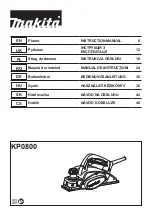
- 14 -
to the end of the workpiece; otherwise it will
produce some unwanted hollows.
PLANING WITH THE SIDE GUIDE (fig.D)
To carry out rebate shaping.
!
!
IMPORTANT! To adjust the side guide you
must work with your hands close to the blades;
therefore unplug the tool from the electrical
supply and wear protective gloves.
Adjust the side guide (pos.8) to the desired width
and tighten the wheel (pos.10).
Adjust the depth guide (pos.15) to the desired
depth and tighten the wheel (pos.16).
Rest the front part of the tool (pos.6) on the first
part of the wooden workpiece and, with the tool
running, move the tool forward over the surface
of the workpiece, pressing down slightly on it.
Make several strokes, so as to achieve the desi-
red depth of the rebate. The maximum depth that
can be achieved is based on the right side guard
of the tool and, when the workpiece touches it, it
will not be possible to carry out further strokes.
We recommend that you do not pause with the
tool on the workpiece or interrupt the machining,
which should be carried out from the beginning
to the end of the workpiece; otherwise it will
produce some unwanted hollows.
PLANING AT 45° (fig.E)
To bevel an edge
!
!
IMPORTANT! This process exposes the
rotating parts and blades, therefore pay
great attention when moving your hands and
the tool.
We recommend carrying out this process on
surfaces that have already been processed and
are perpendicular to one another.
Incline the tool to 45° and place the front part of
the tool (pos.6) on the workpiece at the V groove
(pos.7) and, with the tool running, move the tool
along the corner of the workpiece (lengthways),
applying slight pressure on it. If required, make
more strokes to remove more material.
Once you have finished, switch the tool off, wait
for it to stop completely, lay it on the bench and
unplug it. Do not switch off the device while it
is rotating against the part; wait for it to stop
rotating before placing it down.
MAINTENANCE
!
!
IMPORTANT! Before any checks or
adjustments unplug the tool from the electric
power supply.
!
!
IMPORTANT! Do not tamper or attempt to
repair the power tool.
!
!
IMPORTANT! Any internal service or repla-
cement of the drive belt or the motor’s graphite
brushes, which wear with use, must be carried
out exclusively by an authorised service centre
.
The working life and costs also depend on con-
stant and meticulous maintenance.
Take good care of your power tool and clean it
regularly. In this way its efficiency will be ensured
and its lifespan extended.
- Remove dust and machining residuals with a
cloth or a brush with soft bristles.
- Do not wet or spray water over the power tool
- risk of internal infiltrations.
- Do not use any flammables, detergents or
solvents.
- The plastic parts can easily be damaged by
chemical agents.
- Do not use compressed air for cleaning: Risk
of material ejection!
- Be careful when cleaning the switch, motor fan
slots and handgrips.
REPLACING THE CUTTING BLADES (fig.A)
The blades have two cutting sides and can
therefore be used on both sides; when a blade
no longer cuts correctly, it can be turned to the
opposite side (2nd cutting edge). When both
sides are worn, the blades must be replaced.
Carry out the following tasks on both the blades
mounted on the drum.
Blade disassembly and reassembly
Before proceeding, closely observe the com-
ponents of the tool, the assembly direction of
blade’s cutting edge and fig.A. If you are not fa-
miliar with handling and assembling mechanical
components, we recommend that you consult
an authorised service centre.
1)
Wear protective gloves.
2)
Unplug the machine from the power supply.
3) Fully tighten the screws with a wrench
(pos.23), located in the blade-holder block
(pos.21). Caution! the recess in the drum
made to accommodate the blade-holder
block is trapezoidal and therefore prevents
the extraction of the blade-holder block.


































